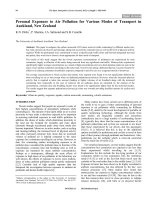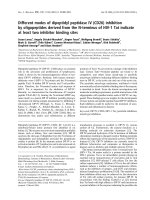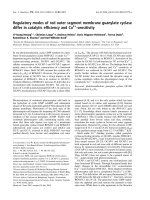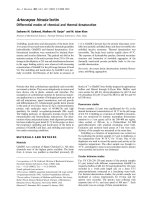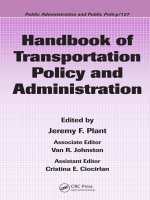MODES OF TRANSPORTATION
Bạn đang xem bản rút gọn của tài liệu. Xem và tải ngay bản đầy đủ của tài liệu tại đây (3.63 MB, 22 trang )
MODES OF
TRANSPORTATION
Mrs. Nguyen Thi Thanh Binh
Presenter
Mrs. Nguyen Thi Bich Thao
Presenter
Mrs. Le Thi Nu
Presenter and designer
Introduction
The content
What is the modes of transportation?
Clarity of some transport modes
Using
Advantage
Disadvantage
Example
Introduction
Modes of transport, means of transport, transport mode, transport
modality or forms of transport are the term used to distinguish substantially
different ways to perform transport
All modes are suitable for transporting goods, and most are suitable for
transporting people.
The modes of transport describes the way goods are transported.
Air transport
is the movement of passengers and freight by any conveyance that can sustain controlled flight. Urgent, perishable goods or high value are
transported by air.
Advantages
Disadvantages
Speed of delivery
costly transport
Weight limits
Some examples of Air transport
Aircraft (Airplane)
Auto gyro
Blimp (Airship)
Helicopter
Parachute
Balloon
(downward air transport only
Water transport
refers to movement of goods and passengers on waterways by using various means like boats, steamers, launches, ships, etc. With
the help of these means goods and passengers are carried to different places, both within as well as outside the country. It is used for big
volumes for international traffic
Water transport
Inland water transport
Ocean transport
Inland water transport use boats, launches, barges, streamers, etc., to carry
Ocean transport refers to movement of goods and passengers with the
goods and passengers on river and canal routes. These routes are called
help of ships through sea or ocean waterways. It plays an important
inland waterways and are used in domestic or home trade to carry bulky
role in the development of international trade.
goods.
Water transport
Advantages
Disadvantages
- For heavy and bulky goods
- Difficulty in monitoring exact location
- For products with long lead times
- Limited to appropriate ports
- Cheaper traffic means
- Transfers to ships take time
Surface transport
Rail transport
For heavy and large loads over long land
journeys
Road transport
Pipelines transport
The most common mode of transport and it is
The main uses of pipelines are oil and gas
used at least somewhere in almost all supply
together with the utilities of water and sewage.
chains.
Rail transport
is a means of transferring passengers and goods on wheeled vehicles running on rails, which are located on tracks
Advantages
Disadvantages
Lowest overall cost per unit weight .
Routes between fixed terminals
Railway is the safest form of transport .
They cannot stop at intermediary points
Can be most effective when linked into multimodal system
Rail transport cannot provide door to door service
R
A
I
L
t
R
A
N
S
P
O
R
T
Advantages
• Main benefit:
Road
- flexibility
- Travel speed .
transport
“ is a type of transport by using roads. Transport on roads
can be roughly grouped into the transportation of goods and
- Use extensive road networks
- Large number of carriers working in the same areas .
- Easy to monitor location of goods
transportation of people. In many countries licensing
requirements and safety regulations ensure a separation of
the two industries.”
Disadvantages
- For shorter distances
- Vulnerable to congestion and traffic delays
- Dependence on fuel price
6 types of trucks used in logistic worldwide
STRAIGHT TRUCKS
JAMBO TRAILER TRUCKS
SEMI TRAILER TRUCKS
TAIL LIFT TRUCKS
REFRIGERATED TRUCKS
FLATBED TRUCKS
Pipelines transport
In modern times, pipelines are used for various purposes. Water supply to residential and commercial areas is carried on with the help of
pipeline. Petroleum and natural gas are also transported from one place to another through pipelines.
Advantages
- Moving large quantities over long distances.
- Cheapest way of moving liquids Local networks can add flexibility
Disadvantages
- Being slow
- Inflexible
- Only carrying large volumes of certain types of fluid
Intermodal transport
Intermodal transportation is the use of two or more modes, or carriers, to transport goods (freight) from shipper to consignee. Special standardized containers
are used for intermodal transport of cargo on trucks, freight trains, and ships.
A
D
V
A
N
T
A
G
E
S
- less noise pollution
- more reliable delivery time notifications
- elimination of traffic and customs processes on the highway
- leaner planning processes fixed departure schedules
- higher quality service standards
- and easier planning and support for large-scale projects.
D
-
I
Speed:
any time cargo is transferred to a comparatively slower means of travel
S
A
-
Lack of Reliability:
as the chain of different modes grows, the possibility of any link in the chain breaking down also increases
D
V
A
N
-
Damage:
Whenever cargo has to be shuffled around, shippers risk the possibility of damage as the freight is transferred from one method of
T
transportation to another
A
G
E
S
-
High Infrastructure Costs:
Intermodal freight transportation also suffers from comparatively high infrastructure costs
Choice of modes
Choice of mode depends on a variety of factors. The main ones are the nature of materials to move, the volume and distance.
Thanks for your listening


